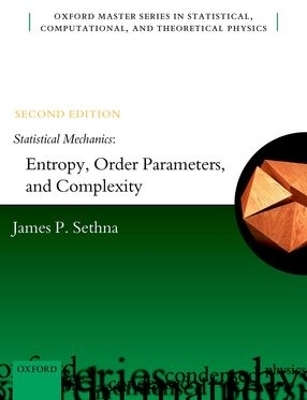
Statistical Mechanics: Entropy, Order Parameters, and Complexity
Oxford University Press (Verlag)
978-0-19-886525-4 (ISBN)
Statistical mechanics is our tool for deriving the laws that emerge from complex systems. Sethna's text distills the subject to be accessible to those in all realms of science and engineering -- avoiding extensive use of quantum mechanics, thermodynamics, and molecular physics. Statistical mechanics explains how bacteria search for food, and how DNA replication is proof-read in biology; optimizes data compression, and explains transitions in complexity in computer science; explains the onset of chaos, and launched random matrix theory in mathematics; addresses extreme events in engineering; and models pandemics and language usage in the social sciences. Sethna's exercises introduce physicists to these triumphs and a hundred others -- broadening the horizons of scholars both practicing and nascent. Flipped classrooms and remote learning can now rely on 33 pre-class exercises that test reading comprehension (Emergent vs. fundamental; Weirdness in high dimensions; Aging, entropy and DNA), and 70 in-class activities that illuminate and broaden knowledge (Card shuffling; Human correlations; Crackling noises). Science is awash in information, providing ready access to definitions, explanations, and pedagogy. Sethna's text focuses on the tools we use to create new laws, and on the fascinating simple behavior in complex systems that statistical mechanics explains.
James P. Sethna is professor of physics at Cornell University. Sethna has used statistical mechanics to make substantive contributions in a bewildering variety of subjects -- mathematics (dynamical systems and the onset of chaos), engineering (microstructure, plasticity, and fracture), statistics (information geometry, sloppy models, low-dimensional embeddings), materials science (glasses and spin glasses, liquid crystals, crackling noise, superconductivity), and popular culture (mosh pit dynamics and zombie outbreak epidemiology). He has collected cool, illustrative problems from students and colleagues over the decades, which inspired this textbook.
Preface
Contents
List of figures
What is statistical mechanics?
1.1: Quantum dice and coins
1.2: Probability distributions
1.3: Waiting time paradox
1.4: Stirling>'s formula
1.5: Stirling and asymptotic series
1.6: Random matrix theory
1.7: Six degrees of separation
1.8: Satisfactory map colorings
1.9: First to fail: Weibull
1.10: Emergence
1.11: Emergent vs. fundamental
1.12: Self-propelled particles
1.13: The birthday problem
1.14: Width of the height distribution
1.15: Fisher information and Cram´erDSRao
1.16: Distances in probability space
Random walks and emergent properties
2.1: Random walk examples: universality and scale invariance
2.2: The diffusion equation
2.3: Currents and external forces
2.4: Solving the diffusion equation
Temperature and equilibrium
3.1: The microcanonical ensemble
3.2: The microcanonical ideal gas
3.3: What is temperature?
3.4: Pressure and chemical potential
3.5: Entropy, the ideal gas, and phase-space refinements
Phase-space dynamics and ergodicity
4.1: Liouville>'s theorem
4.2: Ergodicity
Entropy
5.1: Entropy as irreversibility: engines and the heat death of the Universe
5.2: Entropy as disorder
5.3: Entropy as ignorance: information and memory
Free energies
6.1: The canonical ensemble
6.2: Uncoupled systems and canonical ensembles
6.3: Grand canonical ensemble
6.4: What is thermodynamics?
6.5: Mechanics: friction and fluctuations
6.6: Chemical equilibrium and reaction rates
6.7: Free energy density for the ideal gas
Quantum statistical mechanics
7.1: Mixed states and density matrices
7.2: Quantum harmonic oscillator
7.3: Bose and Fermi statistics
7.4: Non-interacting bosons and fermions
7.5: MaxwellDSBoltzmann 's regression hypothesis and time correlations
10.5: Susceptibility and linear response
10.6: Dissipation and the imaginary part
10.7: Static susceptibility
10.8: The fluctuation-dissipation theorem
10.9: Causality and KramersDSKr¨onig
Abrupt phase transitions
11.1: Stable and metastable phases
11.2: Maxwell construction
11.3: Nucleation: critical droplet theory
11.4: Morphology of abrupt transitions
Continuous phase transitions
12.1: Universality
12.2: Scale invariance
12.3: Examples of critical points
A Appendix: Fourier methods
A.1: Fourier conventions
A.2: Derivatives, convolutions, and correlations
A.3: Fourier methods and function space
A.4: Fourier and translational symmetry
References
Index
| Erscheinungsdatum | 13.02.2021 |
|---|---|
| Reihe/Serie | Oxford Master Series in Physics ; 14 |
| Zusatzinfo | 230 line drawings |
| Verlagsort | Oxford |
| Sprache | englisch |
| Maße | 189 x 23 mm |
| Gewicht | 1012 g |
| Themenwelt | Naturwissenschaften ► Physik / Astronomie ► Festkörperphysik |
| Naturwissenschaften ► Physik / Astronomie ► Thermodynamik | |
| ISBN-10 | 0-19-886525-2 / 0198865252 |
| ISBN-13 | 978-0-19-886525-4 / 9780198865254 |
| Zustand | Neuware |
| Haben Sie eine Frage zum Produkt? |
aus dem Bereich


